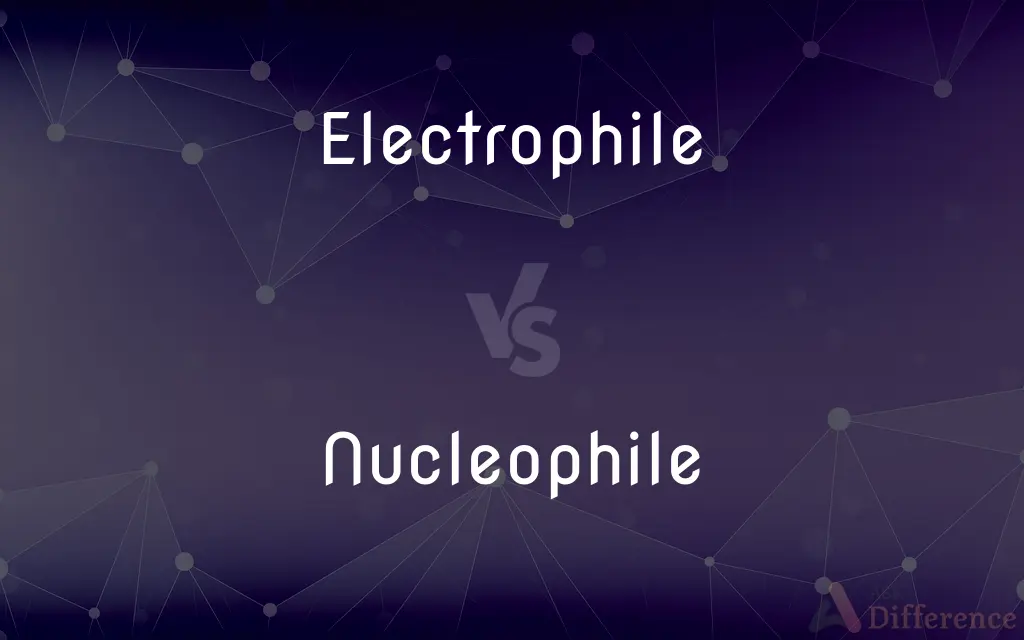Electrophile vs. Nucleophile — What's the Difference?
Edited by Tayyaba Rehman — By Urooj Arif — Updated on April 17, 2024
Electrophiles are electron-seeking species that accept electron pairs, while nucleophiles are nucleus-seeking, donating their electron pairs to form bonds.

Difference Between Electrophile and Nucleophile
Table of Contents
ADVERTISEMENT
Key Differences
Electrophiles, characterized by a positive charge or electron-deficient site, react by accepting electron pairs. Nucleophiles, often negatively charged or neutral with lone electron pairs, react by donating electrons.
Typical electrophiles include ions like H+ or reagents like alkyl halides, which seek to gain electrons to achieve stability. Common nucleophiles include OH-, CN-, and water, possessing available electrons ready for bonding.
In chemical reactions, electrophiles are attracted to regions of high electron density, such as double bonds or negative charges. Nucleophiles, conversely, seek out positively charged or electron-deficient areas to bind.
Electrophilic reactions are often seen in organic chemistry during addition and substitution reactions where electrophiles attack rich electron sources. Nucleophilic reactions are key in mechanisms such as SN1 and SN2 reactions, where nucleophiles replace leaving groups.
Managing electrophiles and nucleophiles is crucial in synthetic chemistry for constructing complex molecules, emphasizing the importance of understanding their reactivity and interaction patterns.
ADVERTISEMENT
Comparison Chart
Charge Nature
Positively charged or electron-poor
Negatively charged or electron-rich
Role in Reactions
Accepts electrons
Donates electrons
Common Examples
H+, AlCl3, NO2+
OH-, CN-, NH3
Reaction Preference
Attacks electron-rich sites
Attacks electron-poor or positive sites
Importance in Chemistry
Essential in addition/substitution
Crucial in substitution/replacement
Compare with Definitions
Electrophile
Any atom or molecule that can accept a pair of electrons to form a new chemical bond.
AlCl3 is used as a strong electrophile in Friedel-Crafts acylation.
Nucleophile
Typically negatively charged or neutral but with lone pairs of electrons.
Water acts as a nucleophile when it participates in hydration reactions.
Electrophile
A chemical species that accepts electron pairs due to its electron deficiency.
In the reaction, the carbon atom of the carbonyl group acted as an electrophile.
Nucleophile
Can be a small molecule, an ion, or a part of a larger molecule.
The hydroxide ion (OH-) is a strong nucleophile used in many organic reactions.
Electrophile
Found in various organic and inorganic chemical processes.
The electrophile sulfur trioxide (SO3) is used in the industrial production of sulfuric acid.
Nucleophile
A chemical species that donates an electron pair to an electrophile to form a chemical bond.
The ammonia (NH3) molecule acts as a nucleophile, donating its lone electron pair to form bonds.
Electrophile
Typically bears a positive charge or a partial positive charge.
The positively charged hydronium ion (H3O+) is a common electrophile in acid-base reactions.
Nucleophile
Involved in key organic mechanisms, such as SN1 and SN2 reactions.
In SN2 reactions, the nucleophile attacks from the opposite side of the leaving group.
Electrophile
Involved mainly in addition and electrophilic substitution reactions.
Benzene undergoes electrophilic substitution when it reacts with nitronium ions.
Nucleophile
Essential for the formation of many biological molecules and synthetic materials.
Nucleophilic attack by amines is crucial in forming peptide bonds in proteins.
Electrophile
In chemistry, an electrophile is a chemical species that forms bonds with nucleophiles by accepting an electron pair. Because electrophiles accept electrons, they are Lewis acids.
Nucleophile
In chemistry, a nucleophile is a chemical species that forms bonds with electrophiles by donating an electron pair. All molecules and ions with a free pair of electrons or at least one pi bond can act as nucleophiles.
Electrophile
An electron-deficient chemical compound or group that is attracted to electrons and tends to accept electrons. Also called Lewis acid.
Nucleophile
An electron-rich chemical compound or group that is attracted to nuclei and tends to donate or share electrons. Also called Lewis base.
Electrophile
(chemistry) A compound or functional group that is attractive to, and accepts electrons, especially accepting an electron pair from a nucleophile to form a bond.
Nucleophile
(chemistry) A compound or functional group that is attractive to centres of positive charge, and donates electrons, especially donating an electron pair to an electrophile to form a bond.
Common Curiosities
What makes a good electrophile?
A good electrophile has a strong electron deficiency, making it eager to accept electrons.
How does the structure of a molecule influence its role as a nucleophile or electrophile?
Molecular structure determines electron distribution, influencing whether a molecule acts as an electrophile or nucleophile.
What makes a good nucleophile?
Good nucleophiles are characterized by their availability of lone electron pairs or negative charge to donate electrons.
How do solvents affect the activity of nucleophiles and electrophiles?
Polar solvents can enhance nucleophilicity by stabilizing charges, while non-polar solvents are better for electrophilic reactions.
What are some common applications of electrophiles and nucleophiles in industry?
They are used in pharmaceutical synthesis, petrochemical processing, and the manufacture of dyes and fragrances.
What is the environmental impact of using strong electrophiles and nucleophiles in industrial processes?
Improper disposal can lead to pollution; hence, environmental regulations must be followed.
What research is being done to develop more effective electrophiles and nucleophiles?
Research focuses on creating more selective and efficient reagents to improve yields and reduce waste in chemical synthesis.
Can a molecule contain both electrophilic and nucleophilic sites?
Yes, molecules like dichloromethane have both electrophilic carbon atoms and nucleophilic chlorine atoms.
What are some safety concerns when handling strong electrophiles and nucleophiles?
Both can be highly reactive and potentially hazardous, requiring proper safety measures to handle.
How do temperature and pressure affect reactions involving electrophiles and nucleophiles?
Higher temperatures generally increase reaction rates, while pressure can affect the solvent’s properties influencing the reactivity.
Share Your Discovery

Previous Comparison
Entrepreneur vs. Entrepreneurship
Next Comparison
Agar vs. GelatinAuthor Spotlight
Written by
Urooj ArifUrooj is a skilled content writer at Ask Difference, known for her exceptional ability to simplify complex topics into engaging and informative content. With a passion for research and a flair for clear, concise writing, she consistently delivers articles that resonate with our diverse audience.
Edited by
Tayyaba RehmanTayyaba Rehman is a distinguished writer, currently serving as a primary contributor to askdifference.com. As a researcher in semantics and etymology, Tayyaba's passion for the complexity of languages and their distinctions has found a perfect home on the platform. Tayyaba delves into the intricacies of language, distinguishing between commonly confused words and phrases, thereby providing clarity for readers worldwide.
















































